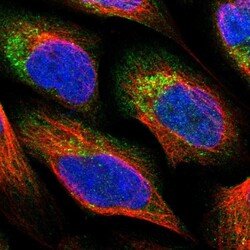Antibody data
- Antibody Data
- Antigen structure
- References [3]
- Comments [0]
- Validations
- Immunocytochemistry [1]
Submit
Validation data
Reference
Comment
Report error
- Product number
- HPA020083 - Provider product page

- Provider
- Atlas Antibodies
- Proper citation
- Atlas Antibodies Cat#HPA020083, RRID:AB_1851849
- Product name
- Anti-PNPLA8
- Antibody type
- Polyclonal
- Description
- Polyclonal Antibody against Human PNPLA8, Gene description: patatin-like phospholipase domain containing 8, Alternative Gene Names: IPLA2-2, IPLA2G, iPLA2gamma, Validated applications: ICC, IHC, WB, Uniprot ID: Q9NP80, Storage: Store at +4°C for short term storage. Long time storage is recommended at -20°C.
- Reactivity
- Human
- Host
- Rabbit
- Conjugate
- Unconjugated
- Isotype
- IgG
- Vial size
- 100 µl
- Concentration
- 0.2 mg/ml
- Storage
- Store at +4°C for short term storage. Long time storage is recommended at -20°C.
- Handling
- The antibody solution should be gently mixed before use.
Submitted references Key regulator PNPLA8 drives phospholipid reprogramming induced proliferation and migration in triple-negative breast cancer
Immunofluorescence and fluorescent-protein tagging show high correlation for protein localization in mammalian cells
The role of calcium-independent phospholipase A2γ in modulation of aqueous humor drainage and Ca2+ sensitization of trabecular meshwork contraction
Tan Z, Deme P, Boyapati K, Claes B, Duivenvoorden A, Heeren R, Tressler C, Haughey N, Glunde K
Breast Cancer Research 2023;25(1)
Breast Cancer Research 2023;25(1)
Immunofluorescence and fluorescent-protein tagging show high correlation for protein localization in mammalian cells
Stadler C, Rexhepaj E, Singan V, Murphy R, Pepperkok R, Uhlén M, Simpson J, Lundberg E
Nature Methods 2013;10(4):315-323
Nature Methods 2013;10(4):315-323
The role of calcium-independent phospholipase A2γ in modulation of aqueous humor drainage and Ca2+ sensitization of trabecular meshwork contraction
Pattabiraman P, Lih F, Tomer K, Rao P
American Journal of Physiology-Cell Physiology 2012;302(7):C979-C991
American Journal of Physiology-Cell Physiology 2012;302(7):C979-C991
No comments: Submit comment
Supportive validation
- Submitted by
- Atlas Antibodies (provider)
- Main image

- Experimental details
- Immunofluorescent staining of human cell line U-2 OS shows localization to nucleoplasm, cytosol & the Golgi apparatus.
- Sample type
- Human
 Explore
Explore Validate
Validate Learn
Learn Western blot
Western blot Immunocytochemistry
Immunocytochemistry